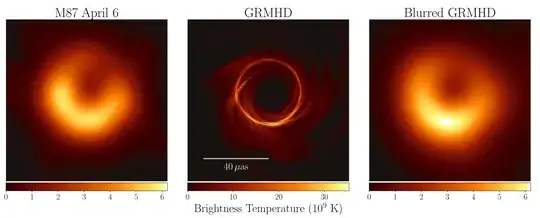Rob Jeffries' answer is excellent, I just wanted to add this picture trying to explain the geometry. Here, I assume a non-rotating black hole (BH); for a rotating BH the exact numbers are slightly different.
The photon sphere
Photons move on straight lines, but in the heavily curved space around a BH these straight lines appear curved. Although the event horizon (EH) at a distance of $r = 2GM/c^2 \equiv r_\mathrm{S}$ (the Schwarzschild radius) from the BH marks the region from which no photons may escape if emitted radially, photons on partially tangential orbit will fall back out to a distance of $r = 1.5r_\mathrm{S}$, where photons traveling fully tangentially will stay on the photon sphere (although this is an unstable orbit).
The innermost stable orbit and the accretion disk
Ordinary matter will spiral inward out to twice this distance; hence, inside the innermost stable circular orbit (ISCO) at $r=3r_\mathrm{S}$, matter is pretty much bound to be absorbed. Outside this region matter may orbit, forming the accretion disk, but since friction between the particles will cause them to lose energy, they will slowly approach the ISCO, after which they will rapidly fall into the BH. Note that the M87 BH doesn't have a thin accretion disk like the one depicted in the movie Interstellar; rather a thick "cloud" surrounding most of the BH.
Photons emitted tangentially just outside the photon sphere will spiral around the BH many times, slowly increasing their distance, until eventually they escape at a projected distance of $\sqrt{27/4}r_\mathrm{S} \simeq 2.6r_\mathrm{S}$ from the BH (e.g. Frolov & Novikov 1998).
The shadow
Just as the path of light rays are curved around the BH, so are the sightlines from you toward the BH (you can think of sightlines as reversed photons). That means that all sightlines that are closer than (a projected distance of) $2.6r_\mathrm{S}$ to the BH will, eventually, end up on the EH, even if taking several orbits around the BH. These sightlines comprise the so-called shadow (Falcke et al.(2000); Event Horizon Telescope Collaboration et al.(2019a), ). On the other hand, along sightlines that a farther away, you see the radiation emitted from the matter falling into the BH, both in front of and behind the BH. And since the first sightlines that don't terminate at the EH circle the photon sphere many times, those sightlines are actually very long paths through matter shining its last light before being engulfed, and hence they look exceptionally bright (e.g. Event Horizon Telescope Collaboration et al.(2019b)). This bright ring just outside the shadow is called the photon ring, or the emission ring.
The drawing
The drawing below may help understand. All the red lines are sightlines toward the BH. Only the uppermost one just grazes the photon sphere (and the luminous matter behind). The rest terminate at the EH, and hence look black (except for luminous matter in front). Close to the center, you see the front of the EH; farther out you actually see the back of the EH; even farther out you again see the front of the EH, and so on ad infinitum until you reach the photon ring.

The observation
Despite the observational resolution being an astonishing $\sim25$ micro-arcseconds, the photon ring is smeared out over a larger region, resulting in the doughnut shape you've seen. That is, what you see in that image is not "the EH in front of an accretion disk", but rather "the EH seen from all sides at the same time and enlarged, with light emitted from the photons ring".
Unless the accretion disk is viewed exactly face-on, half of the accretion disk$^\dagger$ has a velocity component toward you, making it brighter than the other half through a special relativistic effect called beaming. This is seen in the southern part of the M87 BH.
The figure below (from Event Horizon Telescope Collaboration et al.(2019b)) shows, from left to right, the actual observation, a model where you see the rather sharp photon ring, and this model blurred to match the resolution of the observation.

$^\dagger$At least the material just before it plunges into the BH, which follows the rotation of the BH. Farther out, the rest of the accretion disk may in principle rotate the other way.

